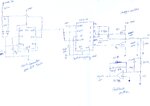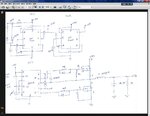Lavanya R
Junior Member level 2
Hello Friends,
I am new here... I want to design buck converter where can be adjustable DC output voltage using buck converter that regulate voltage using switching element (preferably MOSFET) driven by PWM technique using timer 555 converter. PWM technique is applied to switch the transistor fully on and fully off.
The specifications are:
Input voltage: 60V (min) DC
Input current: 10 A
Output current: 10 A
Output voltage: varies as per the duty cycle.
Duty cycle range: 10% to 100%
Please help me out with circuit diagram and component values.
Thanks in advance:grin:
I am new here... I want to design buck converter where can be adjustable DC output voltage using buck converter that regulate voltage using switching element (preferably MOSFET) driven by PWM technique using timer 555 converter. PWM technique is applied to switch the transistor fully on and fully off.
The specifications are:
Input voltage: 60V (min) DC
Input current: 10 A
Output current: 10 A
Output voltage: varies as per the duty cycle.
Duty cycle range: 10% to 100%
Please help me out with circuit diagram and component values.
Thanks in advance:grin:



